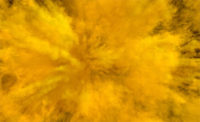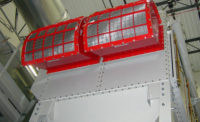Dust explosion control
Choose the dust explosion protection option that will best protect your systems

The potential for a combustible dust explosion is a reality in many manufacturing and processing operations — even within a dust collection system itself. An explosion in an unprotected dust collector produces a high-pressure wave that can fragment the housing and send heat, flames and dangerous projectiles into the workplace. It's imperative to make sure your dust collector is equipped with an effective explosion protection system.
The goal of any type of explosion protection equipment is to control an explosion, keep employees safe, and minimize damage. There are two main types of protective systems you can use — active and passive.
Active systems
Active systems such as chemical suppression/isolation and fast-acting valves react prior to or during a deflagration event. Active systems require detection, control and a pneumatic or electrical response that creates an isolating barrier in response to a deflagration.
Chemical isolation is designed to react within milliseconds of detecting an explosion and can be installed in either inlet and/or outlet ducting. Typical components include an explosion pressure detector, suppressant canisters and control panel. This system creates a chemical barrier that suppresses the explosion within the ducting and can reduce or eliminate the spread of flame through the ducting. It also minimizes the pressure increase within the connected process equipment.
Chemical suppression protects the dust collector itself, whereas chemical isolation detects and suppresses explosions within the ducting. The system detects an explosion hazard within milliseconds and releases a chemical agent to extinguish the flame before an explosion can occur. Chemical suppression with isolation can be used when the collector is located within the manufacturing space. It is also used when the collector is handling hazardous dust that can’t be released directly into the atmosphere or when it is located in a mechanical area where there is no direct access to an outside wall or ceiling location where the explosion vent ducting can protrude.
Fast-acting isolation valves are installed in either inlet and/or outlet ducting are designed to close within milliseconds of detecting an explosion. They create a physical barrier within the ducting that effectively isolates pressure and flame fronts from either direction, preventing them from spreading further through the ducting to the process equipment.
Passive systems
Passive systems react immediately following an event and create an isolating barrier in response to the deflagration pressure to prevent the flame and pressure wave from traveling to other areas and causing more damage. Some passive systems release the pressures produced from an explosion when they have reached a certain limit.
Passive systems include explosion venting, flameless venting, explosion isolation dampers and integrated safety monitoring filters.
Explosion venting is the most commonly used passive system for dust collector housings. It is designed to safely vent the gases and pressures from a deflagration to minimize/eliminate damage and injury to workers in the area. National Fire Protection Association (NFPA) 68 Standard on Explosion Protection by Deflagration Venting sets the criteria for use of these systems. When the dust inside the collector combusts, the pressure inside the collector can reach unsafe levels. The explosion vent opens when the pressure reaches a specified level that is lower than the design pressure of the dust collector.
Flameless vents can be installed over a standard explosion vent to extinguish the flame front as it exits the collector. This enables the venting to be installed indoors depending on the application. A safe area will need to be established around the flameless vent as specified by the manufacturer because pressure is still released from the vent.
Explosion isolation dampers provide an additional layer of protection and are installed in the inlet ducting to create a mechanical barrier that keeps explosion flame and pressure from traveling through ducts into the process area. Normal airflow keeps the flap plate open. But if an explosion occurs, the pressure wave forces the flap closed, so flames and pressure are contained.
Integrated Safety Monitoring Filters (iSMF) are considered an outlet protection device because they protect the downstream (outlet) equipment and work areas. Installed on the top of a dust collector, the iSMF acts as a flame front barrier. In the event of a dust collector explosion, the filter prevents the flame front from exiting the collector and entering the workspace or exiting the collector.
Because combustible dust management is complex, it’s important to use an experienced independent professional engineer to help you design and install your system.
Looking for a reprint of this article?
From high-res PDFs to custom plaques, order your copy today!






.jpg?t=1721257160)
